The Alcan, for the Long Haul
Oddly enough, our Canada-Alaska trip has thus far seen only a scrap of the actual Alcan (Alaska Highway). This is because we chose several different highways to go northbound. In fact, the only parts of the Alcan we’ve been on so far are the short sections between Watson Lake and Whitehorse, and Tok and Fairbanks.
For our return route, we’re taking an all-Alcan path from Tok completely down to Milepost 0, Dawson Creek. This will retrace the 280 miles from Whitehorse to Dawson Lake, but otherwise will be new territory. Distance from Tok to Dawson Creek – 1,255 miles.
Our return trip really began when leaving Nabesna Road in the Wrangell St. Elias National Park. We drove the 50-odd miles up to Tok, turned right, and were back on the venerable Alcan. We were driving in the extended bad-weather system that had descended on the region, apparently to announce the advent of Autumn. And what a system it was. I looked on a weather map, and the clouds, rain, and snow extended from below the US border to above Fairbanks – about 2,000 miles of wet gray swirls, overlaid with the greens and yellows of strong-precip radar returns. We were routinely presented with white/gray skies, sopping wet roads, and very limited views of what I’m sure was spectacular scenery.
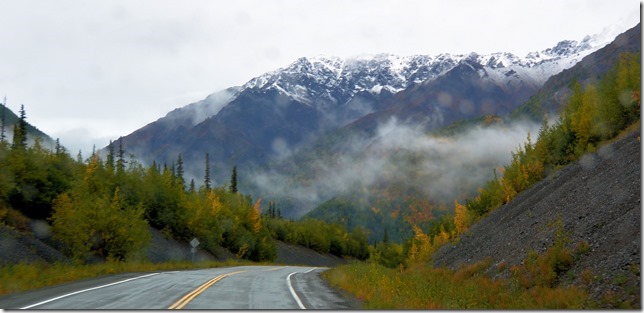
Up to the Border, it was a pretty normal rainy-day drive. Down the road for another 20 miles to Canada Customs, smooth traveling. After that, things started to really deteriorate. This stretch of road is famous for nearly continuous re-construction (extensive permafrost problems), and it lived up to its reputation.
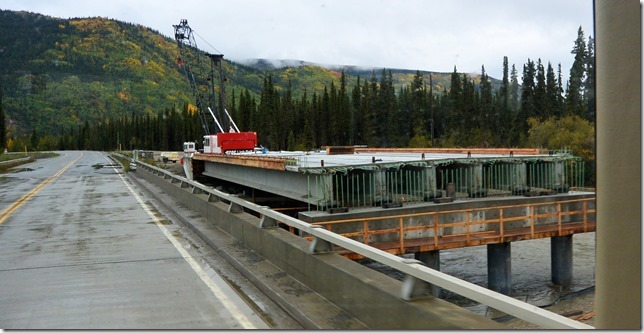
Frequent stretches of rough gravel-repairs interleaved with the good road, which would then be interrupted by long runs of gravel, 10-15 miles at a time. The long runs were almost always flag-gated, and we made several stops as long as 25 minutes waiting for pilot cars to come along and take us through.
In addition, the nearly continuous rain made the road a sloppy shallow sea of thin, runny mud. Some of the longest stretches of gravel seemed to have been abandoned. There were no workers, no flags, nothing except a crappy surface, speckled with potholes from long abuse and absent maintenance. The lousy ride finally ended, with continuous good roads after Donjek River, but the mess had certainly taken its toll. Our normal 50mph average (including stops) was less than 35 for the day. But no worries, y’know – we’re on vacation and we’re retired.
The delays and slow travel gave us plenty of time to look around – still plenty to see. There are always the occasional GFP’s (Glutton For Punishment) to amaze and awe us. A touring cyclist approached one of the many gravel-dirt-mud repair sections. We had no idea how he kept everything that clean.
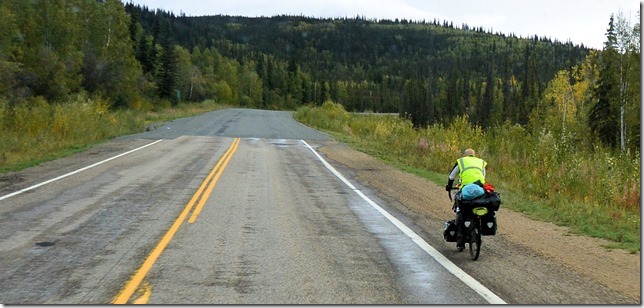
And these two motorcyclists kept swapping places with us. They were apparently somewhat new at their journey, and took seemingly forever to re-lash their gear – at Customs, at flag-stops, clothing-changes, whatever. Best of luck to them, it seems like they’ll need it. Here they are following a pace car through the brown spray.
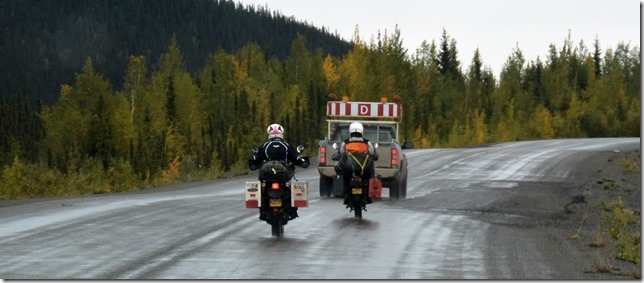
This bald eagle sat atop a spruce and stared through the rain intently – probably at his next meal.
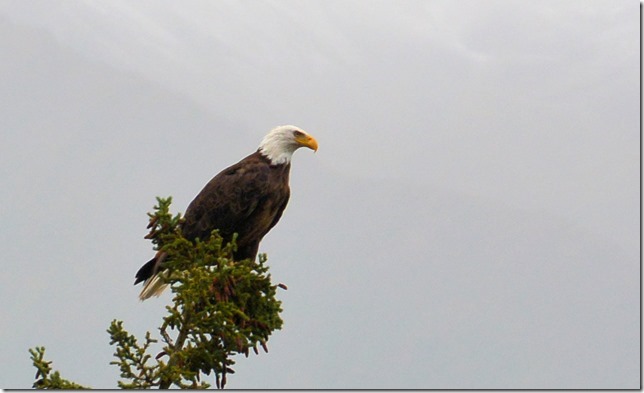
Both before and after the Donjek, we feel that we drove through one of the prettiest regions we’ve seen on this trip. The road winds down along the east side of massive mountain ranges like the Wrangell’s, Kluane’s, and St. Elias’s. They all had a fresh coat of new pure white snow, and they were simply magnificent. They are nearby, and abrupt, jutting almost straight up from the relatively flat, narrow pass that the road navigates along. It’s ironic, that we earlier took the Top-of-the-World Highway (east-to-west) in part because of its reputation for scenic beauty (well deserved, you can read that post HERE###). But I’d put this section of the Alcan right up there with it, or even higher, on the Ooooh-Aaaah scale. Even the crummy weather couldn’t hide it from us, especially when we’d catch a tiny break of blue sky.
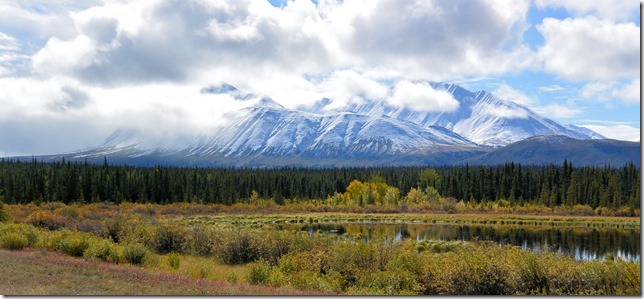
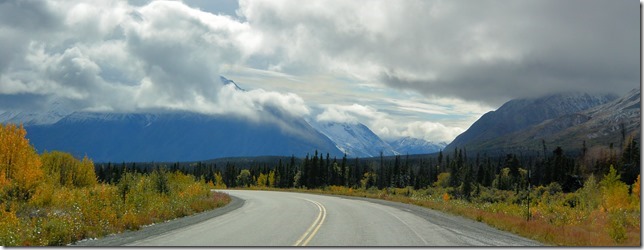
Across from the Kluane National Park (west side of the road), we found a sweet Yukon government campground, Congdon Creek. With our previously-purchased annual Yukon pass ($50), the price is $0. And what a treat. It is set on the edge of Kluane Lake, a large-ish body of water opposite the Park. With all the wind and weather, the lake was well chopped up, maybe two-foot wind swells and fast-lapping surf along the shore.
Kluane Lake is remarkable in another respect – it is extremely accessible. There is very little private land along the shore, and the Alcan runs along the entire western edge of the lake. There are numerous little stubby access roads that lead down to the water and a campfire ring or two. Some of them might even admit Howie, but most are too narrow and rugged. Ralph took them in stride, and we explored the shore a bit. You could walk for miles…
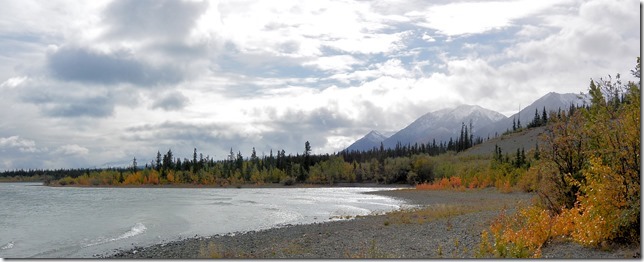
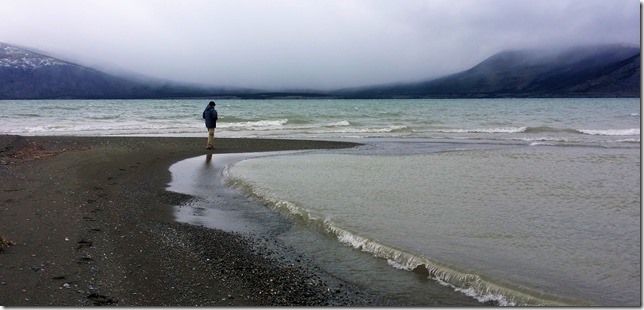
Just across the street from our campground was a stretch of the newly snow-dusted Kluane Mountain range. No need for the STOP sign – we sat there for many minutes just staring at it.
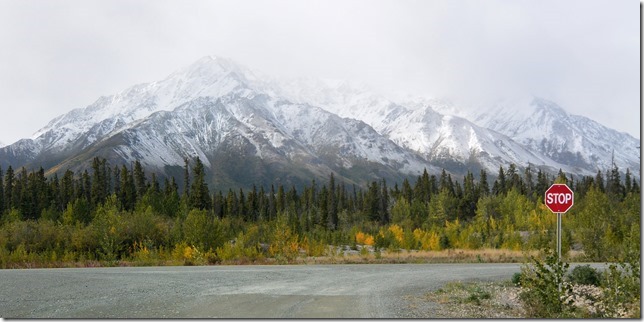
And farther north, at Burwash Landing, there’s an old log church from way back…
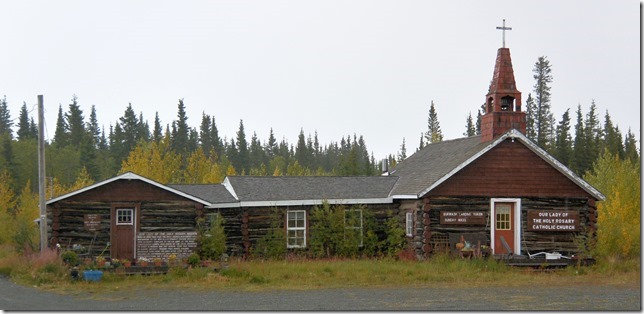
The visitor center for Kluane National Park was the other direction, south down the road from camp, and imagine our surprise when a herd of 300 or so Dall sheep were in attendance as we drove up. The Park has subsistence hunting permitted, but the Natives have agreed to leave this special lambing slope un-hunted. The sheep are about a half-mile from the center, so binoculars and zoom lenses are everywhere.
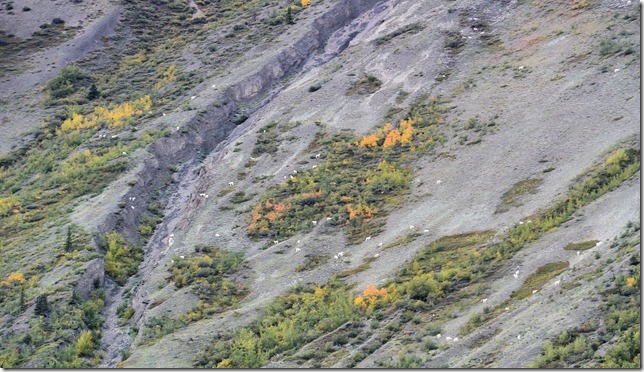
One section of the hillside has a natural mineral-lick area.
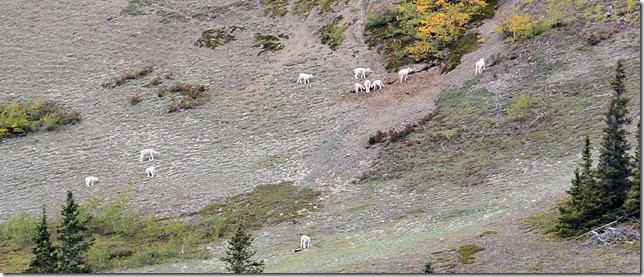
Too bad, our more-planned schedule for our return trip does not give us extra days to spend in the Park. This is definitely a must-come-back spot. It is, like its sister park WSE, a lonely, wild, but somewhat accessible place.
Off down the road again, we drove through your standard Northern August snow flurries.
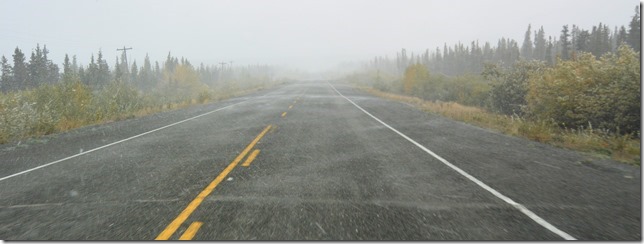
After 60 or so pleasant miles, we passed through Haines Junction. In addition to being the place where one turns south to get to Haines, Alaska, it also has a couple of interesting historical churches. We were not going to Haines, but we did stop for some snapshots of the “quonset” church. It was literally built from a donated military quonset hut. The hut must have been a bit too narrow, for the architect-priest split it in half, added some sky-lights and a steeple, and presto, a church was born. Pretty spiffy, and ingenious, piece of work.
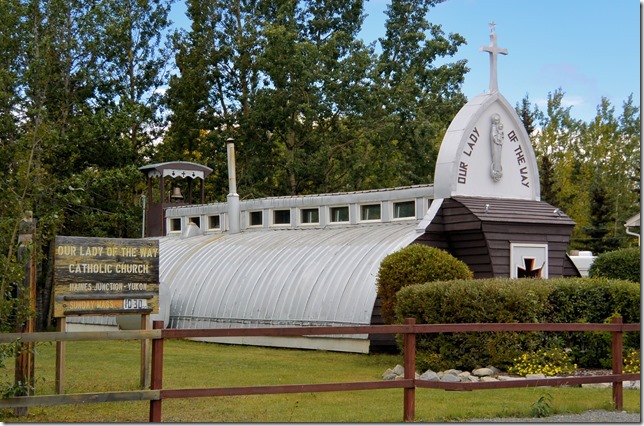
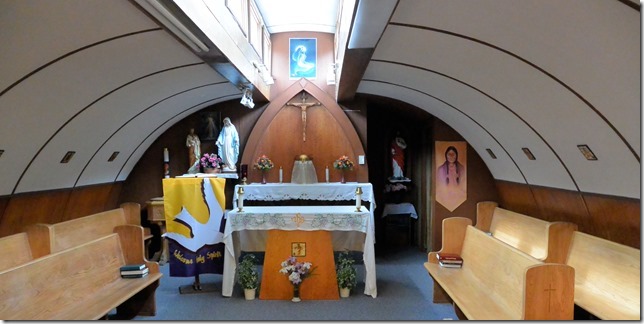
An old photo was on the church wall, showing it way before all the shrubbery grew in. I like it this way.
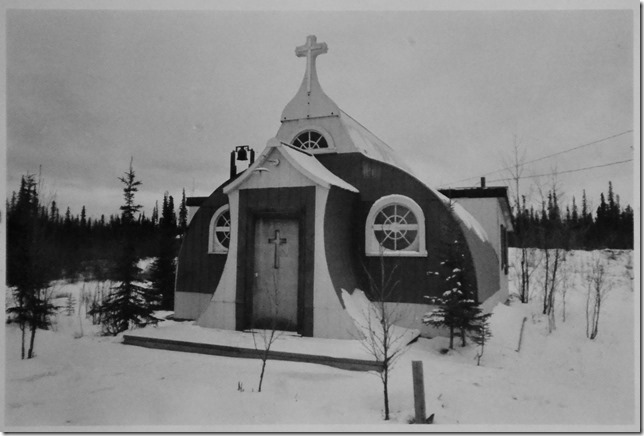
Back aboard Howie and on we went, through drizzling rain, gray skies, snowy mountains. A hundred miles east of Haines Junction, Whitehorse would house us for a couple of days, at our previous camp in Wolf Creek. It’s ten miles out of town, but it’s a good forested camp, free on our annual pass, and the sites are widely spaced. [We have come to really dislike the standard RV park “parking lot” arrangement with shoulder-to-shoulder “sites” – really nothing more than wide parking spots. We’re generally seeking out the forest camps now, putting up with no electric and the occasional generator noise in preference to bread-slice packaging. Cheaper too.]
Whitehorse is now much more impressive to us than on the way up. Back then it was just a large town on the way, but now it’s truly a wilderness metropolis. We are so keenly aware of the total lack of this type of civilization for such long distances, in any direction. (You can read my previous comments about the town HERE.) It is an access-oasis, full of cell phone service, public wifi (visitor’s center), hardware, healthy groceries, and tons of stuff that just can’t be found anywhere for many hundreds of miles in any direction. Nearest cities over 10,000 population? Anchorage, 700 miles; Fairbanks, 600 miles; Dawson Creek, 870 miles; Prince George, 1000 miles. It’s a little ironic, but the excellent access in Whitehorse helps us to appreciate the extreme absence of it, the real remoteness, of the rest of the North.
This time, we weren’t there to explore, just to get a few things (groceries, hardware) and keep on going. On a nagging whim, I decided to try 3G-wifi Canada-style, and I bought a Virgin Mobile phone to use as a hotspot (They didn’t sell just a hotspot). The price per GB was high, about $20, but that’s a bearable expense to get a more frequent connection.
The next morning, the night-time weather had left us a dusting of snow around our campsite. Time to keep moving.
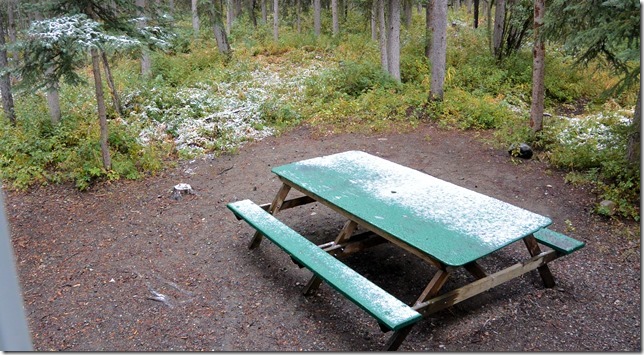
From Whitehorse to Watson Lake, we gradually outran the crappy weather. It’s a pleasant drive, all pretty good road except for the very occasional bridge washout and 10-foot wide construction lane. I figured if the 5-er in front of me could make it through, so could we. Yup.
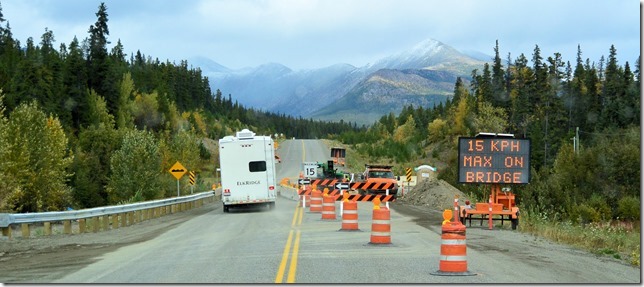
But mostly it was nice road, winding through hills and valleys and past several scenic lakes and rivers. It was definitely a great way to break away from the lumpy gray skies of the last many days.
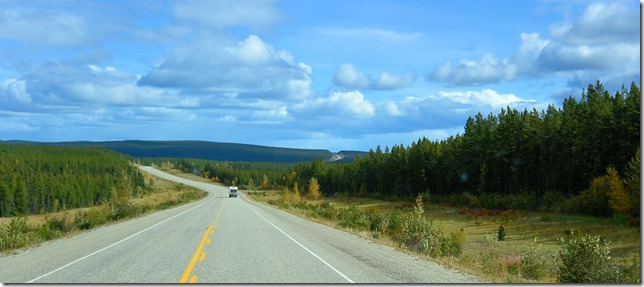
At Watson Lake, we elected this time to go the four miles off-highway and camp at the Watson Lake government campground. That was a good decision – wide-spaced sites, plenty to choose from, and a peaceful 5-mile-long lake almost at our doorstep. With the August sun setting well before midnight, the evening light was very kind.
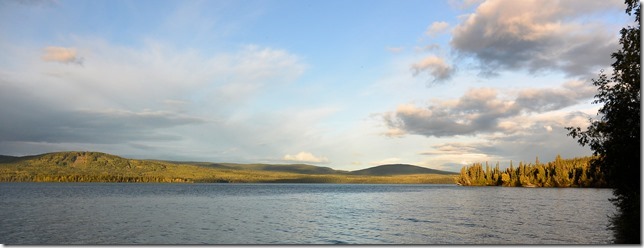
Sadly for my Canada 3G-wifi adventure, there were a few misunderstandings — after a full day of frustration, I was still unable to use it for a wifi link. Unbelievably, Virgin Mobile cannot accept non-Canada credit cards. No idea why, but the only workaround was to buy “minute cards” with my US Mastercard, and then vouch them to the account.
Now that I understand all of this better, I might manage it differently the next time into Canada. Any older phone would work (we have a couple), as long as it has hotspot capability; just buy a sim card for $5 and get a pre-paid account card. That would have saved me the $125 for the phone. Oh well. Still worth it over trying to find decent public wifi in Canada (very rare). Even the paid wifi at RV parks mostly stinks, and many have arbitrary time limits and then auto-shutoff.
All around our campground, mushrooms are growing prolifically in the damp forest, in a crazy profusion of varieties. There must be dozens of different fungi sprouting up through the dank earth, in sizes from a small coin to larger than my outstretched hand. Karin has an affinity for wild mushrooms, but not a lot of training. Even the excellent book we bought is not 100% insurance against eating the wrong kind, which can be deadly. Fortunately, we ran across a wonderful German couple who were educated about the “good” ones, and had recently picked and eaten one type. They very generously gave us some samples, and we found some more to match. It’s a Bolete variety, and Karin reports it to have a pleasant and distinct flavor. I respectfully and wistfully abstained, just in case someone needed to be driven to the hospital. The others? – they’re just for looking at right now. I’m sure that many of them are edible, but it’s just too big a chance to take.
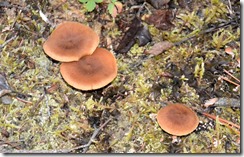
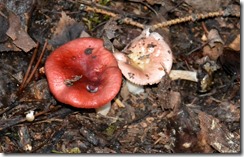
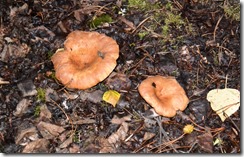
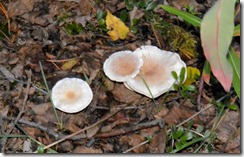
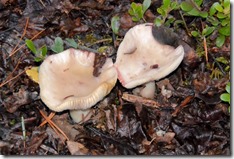
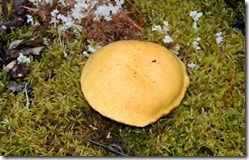
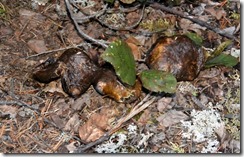
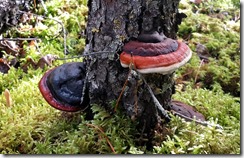
The next morning, Karin was still standing, smiling smugly as she fixed some breakfast. Out in the campground, I passed by some stalwart travelers touring by motorcycle and trying fruitlessly to dry out some gear. That kind of travel is a polar opposite to our oh-so-spoiled luxury in Howie. Each to his own.
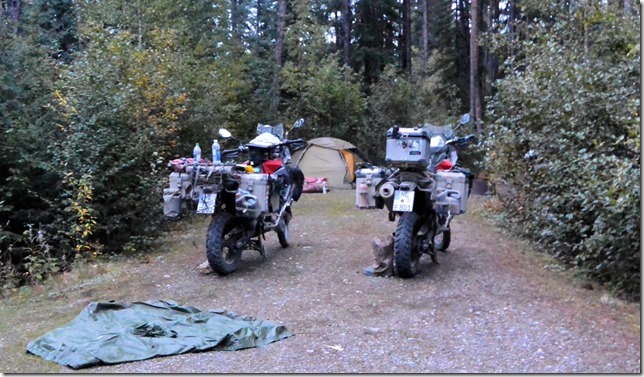
We’re off toward Fort Nelson this morning, and likely to stop at Liard Hot Springs along the way. Forecast is calling for some sun in the next few days – but you know how those guys lie.

Good call on Kluane. 31 years ago, we too stopped there on our way south after two months of small pickup truck based camping. It was late September and besides us, there was only one motorhome in the campground. The retired couple invited us inside to share freshly baked cake. Oh my god, what a treat after two months of eating the bare necessities outdoors!
Second rememberance, Watson Lake. Again there was only one other occupant of the large campground, a Canadian guy and his young Indian bride and baby. They were on their way to visit her family. The couple came over to visit with us at our picnic table. I noitced the campground was littered with bear scat, but didn’t tell my city-girl wife. But the jig was up when the husband said to me: “If you see a bear, let me know. I have still have a tag left.”
After they went back to their camper, my wife asked me what the guy was talking about. Once she found out, she had a restless night’s sleep!
We did our San Diego to Inuvik and back trip from August thru September specifically to avoid cramped campgrounds. It worked. And those crisp mornings with a dusting of snow guarentee one thing, no mosquitos!
To avoid the “horse running back to the barn” syndrome on our retirn leg, we took the ferry from Ketchican to Port Angeles with three stops of a day or two, then we spent a week on the Rouge, at a beautiful fishing lodge just east of Gold Beach, OR. This slow re-entry to civilization, beds, flush toilets, and showers worked out great!
Thanks. To us your cost of trying to find internet is worth it!
Thanks for the update on the Alcan Highway. We leave next week from up here in North Pole where we are trying to view the Aurora.Clear skies but lots of moonlight:/
Enjoy the Rockies should be beautiful. Eastern road to Ft. Nelson was really torn up east of Summit Lake, Still recommend Toad River which is just past Llaird Hot Springs. They have wooded sites on the pond with good WIFI included for cheaper rates than most.. Nice break before returning to the “oil patch” traffic & all.
Having had the same nightmare with 3/4G hotspot works good in AK but gave up in CAN and resigned to hit or miss in RV sites. Another good spot included on the trip east is at Ft. St. John Rotary Park on Charlie Lake good facilities boring RV sites. Thanks again for your posts and input.
Have Fun!